'There will always be hiccups given that the Namami Gange programme is spread over different sectors and involves several agencies.'
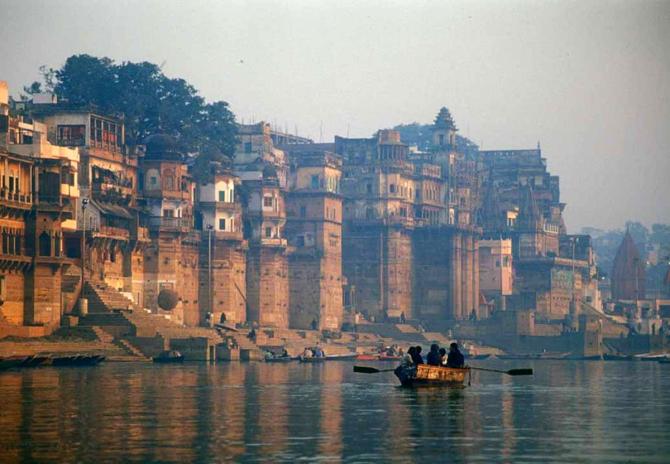
Prime Minister Narendra Modi had famously declared the Ganga as his mother with Ganga rejuvenation and the launch of the National Mission for Clean Ganga to clean up the river being amongst the first decisions of his government.
On World Environment Day, June 5, Director General Rajiv Ranjan Mishra, heading the NAMAMI Gange project, speaks with rare candour about the successes and failures in cleaning up the river during the last seven years in an exclusive interview with Rediff.comRashme Sehgal .
Successive governments have promised to clean up the Ganga with little success on the ground.
The Modi government launched an ambitious Rs 20,000 crore programme called Namami Gange and yet we have the Central Board of Pollution Control state that the river remains as polluted as ever with its water being unfit for bathing and drinking?
What are your views on this?
For the first time, with the launch of Namami Gange, an integrated approach was put in place covering the entire length of Ganga and also its ecosystem with multi-sectoral interventions.
These include abatement of pollution from all sources (Nirmal Ganga), improving ecology and flow (Aviral Ganga), strengthening people river connect (Jan Ganga) and R&D, Knowledge management (Gyan Ganga). All these interventions have made significant inroads towards Ganga rejuvenation.
It is not correct to say that water quality has not improved by quoting some selected indicators.
A major indicator of it is dissolved Oxygen (DO) and it is remarkable that the entire length of Ganga has more DO than the prescribed minimum level of 5mg/l.

Rajiv Ranjan Mishra
Photograph: Rajiv Ranjan Mishra/Twitter
River water quality has shown improvement between 2014 and 2019.
The dissolved oxygen level has improved at 27 locations, while biochemical oxygen demand (BOD) and faecal coliform (FC) has improved at 42 and 21 locations, respectively.
This data has been provided by the Central Pollution Control Board only.
Our efforts towards cleaning the river have been targeted towards meeting bathing quality criteria for river water.
In fact, out of the 351 polluted river stretches identified by CPCB in India, no stretch of the river Ganga falls in into the most polluted category.
During the last five years, we have completed sewerage projects in all major towns and cities along the Ganga in the states of Uttarakhand and Jharkhand.
More than half of the projects in Uttar Pradesh along Ganga have been completed.
We had to start practically from scratch in Bihar where sewage treatment capacity has been increased almost 10 times from 60 to 620 million litres of sewage per day (MLD).
140 MLD has been added in Patna through three new STPs during the last year.
Projects in West Bengal are also under execution. Once all these STPs are commissioned, most of the raw sewage falling into Ganga will be tapped.
There is also continuous efforts to minimise and check effluent discharge from grossly polluting industries.
To this effect, a CETP (common effluent treatment plant for tannery) has been taken up for the Kanpur Jajmau Tannery cluster.
Black liquor discharge has been stopped in paper and pulp industries located the river.
I would say, that with Namami Gange we have learned from the previous river cleaning projects and honed solutions based on technical knowledge from expert institutions and international expertise.
Since 2014, we have been reaching important milestones. Sisamau Nala, which had been spewing 140 MLD of raw sewage into river Ganga for over a century was tapped and diverted to two STPs.
Kumbh 2019 saw devotees and pilgrims happy over the good quality of river water.
There is still work to be done, as river cleaning is a continuous process, and we are confident of completing the establishment of sewerage infrastructure within the next two to three years.
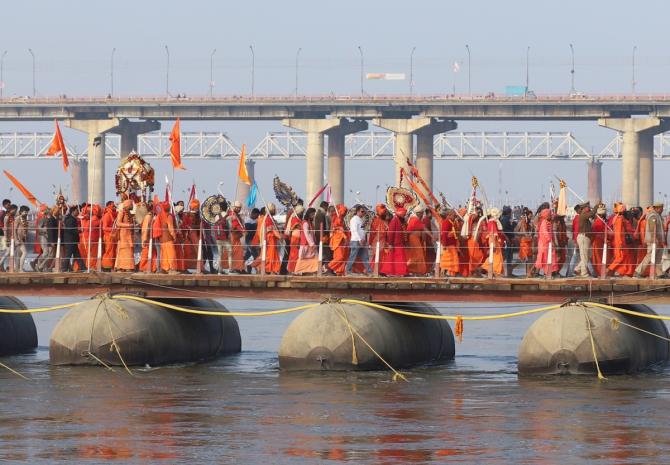
Prime Minister Modi had given an assurance in Varanasi in 2014 that not a drop of sewage would be allowed to enter the river
But we find that even today there were 33 sources of pollution in a stretch of 5 kilometres where raw, untreated sewage flows into the Ganga in this city. It had been estimated that sewage generation in Varanasi is around 350 MLD.
A large amount of sewage gets discharged into the Varuna and Assi rivers which end up flowing into the Ganga at Varanasi.
How much cleaning has been done so far?
Significant progress has been made for Ganga rejuvenation in Varanasi with several long-pending projects either getting completed or at final stages.
You are right about the sewage generation to be about 350 MLD.
In 2014, the sewage treatment capacity for Varanasi was just about 100 MLD out of which 80 MLD was being done at Dinapur.
A modern STP of 140 MLD capacity was added at Dinapur with several innovative features including the generation of power internally for its operation.
120 MLD STP in Goitha has also come up. These take care of most of the drains, except three including Assi Nala.
A new 50 MLD STP at Ramana has just got completed and is under trial and has already taken some pollution load away from Assi Nala.
So, since 2014, we have added 310 MLD treatment capacity to the existing 100 MLD, making it a total of 410 MLD, adequate to meet the sewage treatment demand till the year 2035.
Now focus is on close monitoring of all these plants and their associated network with the Old Trunk sewer also being rehabilitated.
I must here highlight that we have completed the task of repairing 26 ghats in Varanasi and have hired an agency to clean 84 ghats in the city twice a day.
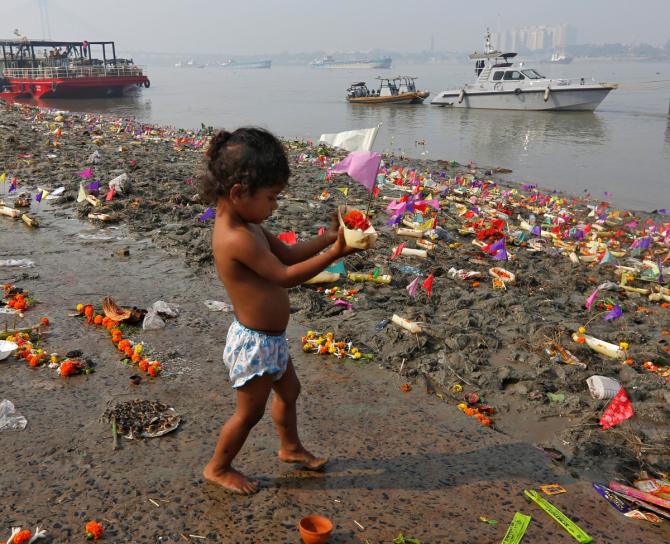
STPs capacity across the cities that are located on the banks of the Ganga such as Haridwar, Rishikesh Kanpur, Allahabad, Farrukhabad, Varanasi, Patna, Bhagalpur, Kolkata, Howrah and Bally are much less than the requirement.
Patna, for example, had no STP so what has been done to alter this. Can you elaborate on this?
Projects have been sanctioned to meet sewerage treatment capacity till the year 2035 for all major towns and cities along Ganga including the ones mentioned above.
We have gone with a comprehensive mapping of the sewerage status of all towns along Ganga.
Out of the 157 projects targeted at creating over 4,900 MLD capacity, 61 projects have already been completed.
This includes projects on tributaries as well which were taken up mostly from 2019, as initially priority was given for projects on the main stem of Ganga.
The remaining projects are at various stages of execution and should be completed in the coming two years.
In 2014, we had only 28 projects on hand and these were also smaller ones as the total capacity involved was only 462 MLD.
Let's take a quick look at some of these cities. Haridwar and Rishikesh are two major cities that had high pollution loads.
Major capacity additions have taken place here with the capacity of Haridwar being increased from 45 MLD to almost 150 MLD with the completion of several projects including the first Hybrid annuity mode STP projects at Sarai and Jagjeetpur. At present entire sewage flow of 114 MLD is being treated.
Similarly, in Rishikesh 26 MLD STP and Muni ki Reti area 7.5 MLD STPs have started.
In Kanpur, a major project with one city-one operator approach has been taken up constructing required new STPs at Pankha for 30 MLD and at Unnao and Shuklaganj and the same concessionaire has taken over O&M of all existing STPs.
Most of the drains including the massive 140 MLD Sisamau drain has been tapped. Prayagrag again is a city where entire sewerage infrastructure has been completed and all have been put under one operator for upgradation.
Patna and Bhagalpur contribute to more than 50 per cent of pollution flowing to the Ganga from Bihar and therefore remain our special focus with Rs 5,000 crores (Rs 50 billion) worth of interventions taking place in this city alone.
Patna despite being a capital city did not have a sewerage network and we have started 11 projects in Patna alone worth Rs 3,000 crores (Rs 30 billion).
Projects have also been awarded for Bhagalpur, Kolkata, Howrah, and Bally.
In terms of setting up Sewerage infrastructure, we have learnt our lessons from the previous clean-up projects and moved from not only constructing the STPs but also monitoring their performance and also ensuring Operation and Maintenance for the next 15 years.
The Hybrid Annuity Model was accorded Cabinet approval with 100% central sector funding.
It ensures the development, operation and maintenance of the STP will be undertaken by a Special Purpose Vehicle at the local level.
As per this model, 40% of the Capital cost would be paid during construction while the remaining 60% of the cost will be paid over the life of the project as annuities along with operation and maintenance cost expenses for the next 15 years.
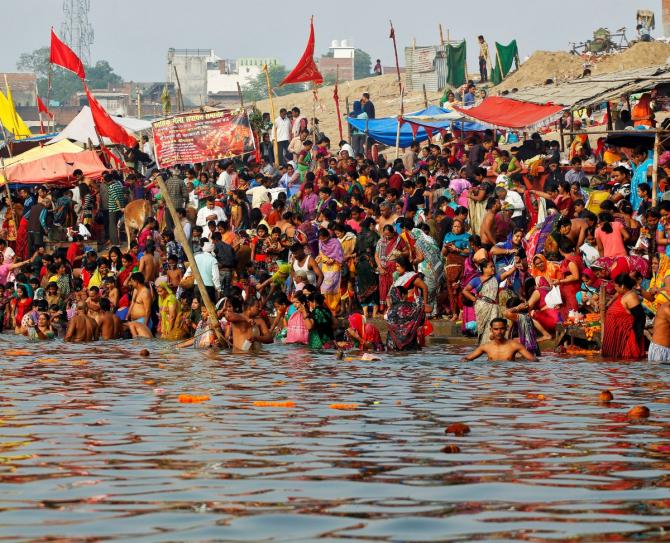
You have been quoted as saying you are also working on the tributaries of the Ganga. What work is being executed in the tributaries?
Namami Gange since 2014 has been based upon basin approach drawing from the report of the consortium of 7 IITs who developed the Ganga River Basin Management Plan.
This has led it to adopt a multi-sectoral approach towards the river including its tributaries, wetlands and flood plains.
The initial success in securing sewerage infrastructure for the year 2035, has catapulted other major initiatives such as afforestation, biodiversity conservation, organic farming and wetland conservation.
Till date, we have sanctioned 40 sewerage projects on various tributaries of Ganga accounting for about 2,650 MLD treatment capacity at a cost of Rs 7,750 crores (Rs 77.50 billion). These projects are at various stages of execution.

An expenditure of over Rs 10,000 crore (Rs 100 billion) has already been spent on this cleaning process. Can you provide a broad break-up of what the thrust expenditure has been?
Namami Gange has been established on two cornerstones of Aviral and Nirmal Ganga.
The interventions for Nirmal Ganga are in the nature of development and operation of infrastructure for sewage treatment, industrial effluent treatment, solid waste management and hence they are capital intensive needing most of the financial resources so far.
We have also spent a sizable amount for Aviralta and improving ecology and to achieve this objective we have taken the support from other ministries such as the Ministry of Agriculture for organic farming and Ministry of Rural development for the rejuvenation of small rivers and waterbodies.
Out of a total of 341 projects under Namami Gange, 157 are for creating sewage treatment capacities.
These projects have been sanctioned at a cost of Rs 23,900 crores (Rs 239 billion), from Namami Gange's total sanctioned projects amounting Rs 29,972 crores (Rs 299.72 billion).
This includes the cost of O&M for STPs for 15 years after commissioning of the plant.
Approximately sector-wise allocation is to the tune of industrial pollution abatement activities -- Rs 1,000 crore (Rs 10 billion); improving flow, ecology (afforestation, biodiversity, wetland conservation and spring rejuvenation) -- about Rs 1,000 crore; riverfront developments, ghats and crematoria and construction, repair and cleaning about Rs 1,500 crore (Rs 15 billion; rural Sanitation, organic farming, medicinal plantation, Ganga Gram another Rs 1,200 crore (Rs 12 billion).

How much has the ecological flow of the river improved following your initiative?
A landmark first of its kind policy decision was taken to notify e-flow for river Ganga in October 2018.
This regulates minimum flow to be released in different seasons by the hydroelectric projects as well as irrigation barrages from headstreams of Ganga up to the Kanpur Barrage.
The e-flow in Ganga though improving, will need more efforts.
To do so, there is a need for taking up demand-side management also which means improving water use efficiency in agriculture which is the largest consumer of water.
Proper cropping practices, water conservation and reuse in different sectors must be promoted to introduce greater water efficiency.
We have taken up 226 wetlands within 10 km of the Ganga in UP and are trying to conserve and protect them. Rejuvenation of springs has been taken up in Uttarakhand.
We are also giving priority to the rejuvenation of small rivers by local efforts.
We got them included as priority areas under MNREGA and District Ganga Committees have been sensitised and trained for this.

You have also been quoted as saying 'We are doing scientific mapping of the river'. Can you explain this in greater detail?
We are doing scientific mapping of the Ganga with a host of institutions trying to gauge and measure different aspects of the river.
This is very valuable in laying down the foundation for evidence-based policymaking and in developing a framework for river rejuvenation across all our rivers.
To cite some examples. We are working with the Survey of India to generate a high-resolution DEM & GIS-ready database using LIDAR as well as ground-truthing.
This will help in project planning and monitoring and the entire public drainage networks in towns along Ganga would come under high-resolution GIS platform.
We have brought in the Wildlife Institute of India to map the aquatic life along the Ganga, identify hotspots and take up interventions for habitat and species conservation.
In the same manner, we have sought the help of the Forest Research Institute to map the flora and to develop a scientific plan for afforestation along the Ganga.
The Central Inland Fisheries Research Institute is helping us develop conservation strategies for different fish species while the CSIR-NEERI are helping us do a microbial mapping for the entire length of the Ganga Ganga.
Similarly, INTACH is helping us do a district-wise documentation of the cultural heritage along Ganga as also help us come up with preservation cum development strategies.
ISRO has helped us develop the Bhuvan Ganga Geoportal and IIT Kanpur has helped us with reconstructing the Ganga of the past using corona archival imagery.

Construction of dams on the upper reaches of the Himalayas on the Ganges and its tributaries is a matter of concern because their construction has a direct impact on the flow of the river.
Have you made any effort to work towards finding a holistic solution to this problem?
River flows do get adversely impacted by the construction of dams and barrages.
Several saints have also been raising their concerns on this matter.
The Bhagirathi region between Gangotri and Uttarkashi has been declared an eco-sensitive zone in Bhagirathi region and the need for doing some work for determination and implementation of e-flow also emerged.
For the first time, e-flow has been notified vide notification dated 9th October 2018 for the Ganga, starting from all the headstreams of the Ganga up to Haridwar in Uttarakhand and from Haridwar to Unnao in Uttar Pradesh.
This is a watershed policy initiative as it specifies minimum environmental flows for the Ganga and also for the first time legally recognising the right of the river over its own water which is absolutely essential for ecological sustainability.
The notification is applicable to all existing, under-construction and future projects and was brought in to ensure that the river has at least the minimum required environmental flow of water even after the river flow gets diverted for different projects.
The e-flow notification gave companies three years to modify their design plans in order to comply with these new rules.
In September 2019, however, this deadline was advanced, from October 2021 to December 2019 after the Central Water Commission, which is responsible for monitoring e-flows, undertook field visits to hydropower sites.
We have also been working closely with the ministry of environment and ministry of power to minimise the intrusion of new dams in the higher reaches of the Himalayas.
Our ministry has clearly indicated its views to the environment ministry that apart from identified few HEPs which are at an advanced stage, no new project should be taken up in this fragile area.
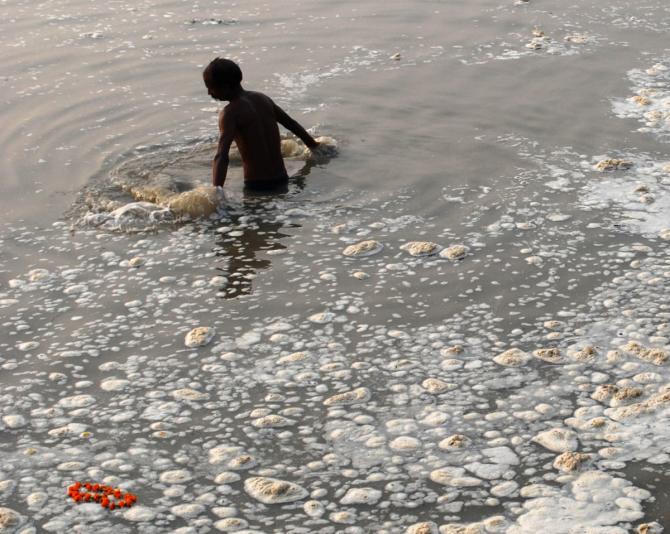
The National Mission for Clean Ganga has been quoted as stating that the progress of sewerage projects has been 'severely impacted due to the COVID-19 pandemic and the extraordinary situation prevalent in the country.'
For example, STP construction has been delayed in Bihar because of the 'inordinate delay for want of finalisation of tenders by the state government' and sometimes for very trivial reasons.
Can you elaborate on this?
Sewerage projects, especially at the scale of the Ganga's current treatment gaps versus treatment requirement of 2035, are considerably large projects that have been taken up by Namami Gange.
Execution of projects of such scale and complexities would see delays in getting suitable lands, permissions from different authorities and in procurement processes.
We have tried to streamline the process of project preparation and sanction with the development of standard documents.
There will always be hiccups given that the Namami Gange programme is spread over different sectors and involves several agencies.
But with closer monitoring, delegated system and the use of technology, we have been able to expedite several projects and reduce the time taken to complete STPs.
No financial constraints have been felt at any of the projects in our mission, unlike previous programmes.
A strategic decision was taken to fund this from the central government, including not only construction work but 15 years O&M also.
Procedural requirements in different states vary and it is not correct to isolate any particular state for this.
Delays in the finalisation of tenders by the State governments have, however, not been taken lightly.
The COVID-19 pandemic was such an unprecedented disaster, no one could have anticipated its impact and certainly, it led to some disruption, but we could still control its impact on our projects to a great extent.
In fact on some of the major project sites, we have retained a large number of workers.
We also focussed during the lockdown on getting approval of designs and permission from authorities. Several major projects were completed during 2020-2021.
Feature Presentation: Rajesh Alva/Rediff.com










